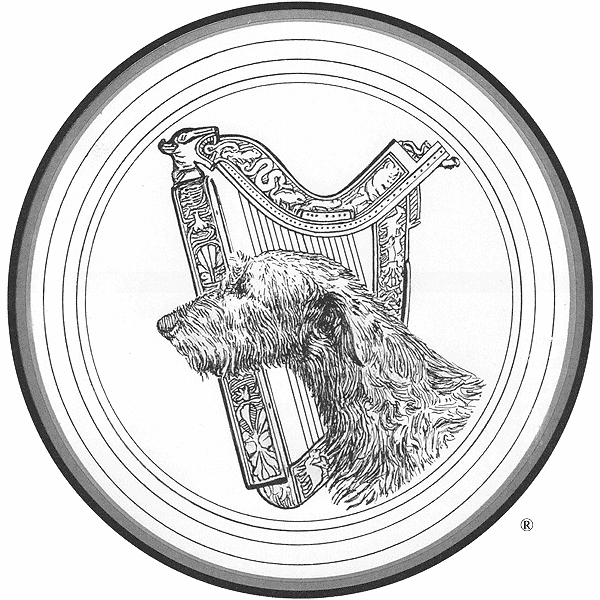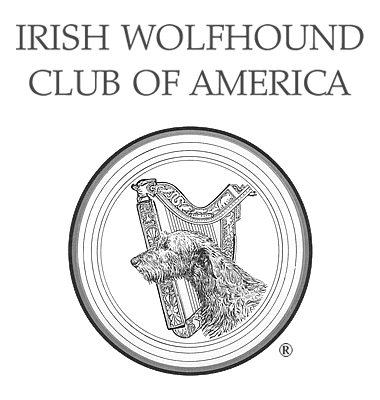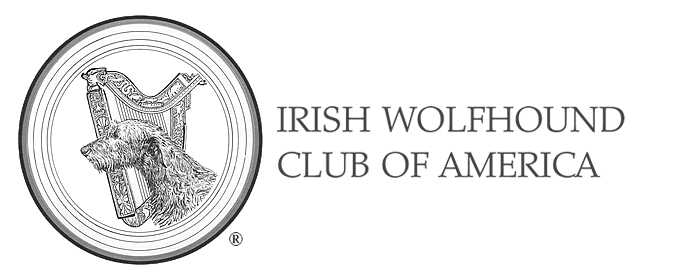Megaesophagus
originally published in Harp and Hound Volume 2 1983 and updated by the author March 2014
As dedicated fanciers of Irish Wolfhounds it is important that we learn as much as possible about any problem that affects the health and well-being of our hounds. Hopefully we don't have to experience all of these problems and heartaches firsthand in order to be able to learn from and share our experiences. One such problem, megaesophagus, became a very personal heartache for me. I hope that the information gained may eliminate some misconceptions about the condition, and help inform people as yet unfamiliar with it.
My own experience with megaesophagus began with the long awaited arrival of a carefully planned litter. Several puppies became affected. #1 was relatively small at birth, 14 oz., as opposed to his 20 to 24 oz. littermates. He lacked vigor and was not a strong nurser. Something didn't seem right, but we decided to work with him and give him every chance we could. I spent a good deal of time in the whelping box and saw to it that he had every opportunity to nurse his dam. At 1½ weeks he quickly developed a "congestion" sound, but no nasal discharge or fever. After an examination the veterinarian made a tentative diagnosis of pneumonia — cause as yet undetermined — and prescribed a broad spectrum antibiotic. There was intermittent regurgitation and some milk bubbling from the nostrils. I continued the medication and worried. At three weeks #2 started the "congestion" and vomiting. #1 had fallen far behind, weighing 3 lbs. 13 oz., while weight on #2 was 71b. 4 oz., and #3 was 7 lb. 9 oz. All puppies were checked by the veterinarian again and #1 was given further treatment by injection. #1 and #2 were also treated with antibiotics and a decongestant. The probability of the problem being megaesophagus was discussed at this point.
No real change in condition ensued. The vomiting of milk continued in the two puppies, sometimes promptly after nursing, sometimes up to two hours after feeding. It appeared undigested. The weights at four weeks were: #1 6 lbs., #2 8 lbs., and #3 9¼ lbs. At this time #2 was starting to noticeably fall behind. Both puppies had developed an off and on nasal mucus discharge in addition to the lung congestion. Between four and five weeks the entire litter started to be weaned. We began with Gerber's Baby Beef from the finger, then the beef and Gerber's Hi-Pro. Cereal, and progressed to beef, finely blend puppy chow and evaporated milk. They were fed four times daily with the food elevated to chin level. We tried supplementing with blended cottage cheese, yogurt, and then off all milk products in the long shot that it could be an allergy to milk. There was no appreciable change in the gradually deteriorating condition of the affected puppies. At five weeks #3 started vomiting. We continued the diet and medication. Six week weights were: #1 8½ 1bs., #2 13 lbs., #3 16 lbs. The affected puppies were placed on a diet of finely ground puppy chow, Hill's P.D., the consistency of thick soup, every two hours from 5 a.m. to 11 p.m., in small amounts. The puppies ate with their front feet on a step and food dish elevated to chin level. This did not seem make a significant difference in the vomiting. We noticed that the puppies did better in the morning with regard to keeping the food down, but toward evening they were unable to keep much down. Obviously there was back-up of food in the esophagus. At seven weeks #1 weighed 9 lbs., #2 14lbs., and #3 17 lbs. These three puppies showed normal development of eyes and ears, walking, and personality. The overall condition was poor, lacking in size and bone, and noticeably down in the pasterns. At seven weeks the congestion had gradually changed to a distinct sound in the throat rather than sounding like it was in the lungs. There was an obvious pulsation of the esophagus at its junction with the chest. We still saw occasional nasal discharge. Barium rays confirmed the diagnosis of megaesophagus.
Our veterinarians had been in continual contact with specialists at Colorado State University Veterinary Hospital, and approached us with their request that the puppies be donated to CSU in the hope that through further Barium X-rays and finally autopsy some knowledge might be gained. After a great deal of soul searching, consulting with the veterinarians involved, and talking with breeders that had donate dogs with different problems to CSU with favorable reports of care and management, the decision donate the puppies was made. This was done with the stipulation that we expected them to be lovingly raised for the duration of their lives, and under no circumstances was any sort of experimentation to be done on them. Our alternative was to euthanize them locally. We felt our decision a good one in that something could be learned about the problem.
#1 was euthanized soon after donation from complications resulting from aspiration pneumonia. Necropsy revealed only a large dilated esophagus. No significant findings were made from microscopic examination. #2 was euthanized not long after this, and because of aspiration pneumonia. Just prior to this surgery had been required to correct two gastrointestinal problems resulting from the vomiting (Gastroesophageal intussusception and an intussusception of the small intestines). These problems occur when one segment "telescopes" into another segment. After the surgery the aspiration pneumonia became so severe we felt the humane thing to do would be to perform euthanasia. Again, other than an enlarged esophagus there were no significant findings. #3 was "adopted" by a graduate veterinary student and lived at home with frequent elevated feedings. Although he grew to normal IW size and the vomiting and complications resulted in euthanasia at a little over a year of age. Currently are three litters of various breeds with megaesophagus at the hospital. All of these puppies are closely observed in hopes of gaining information on this problem.
Cases of megaesophagus in Irish Wolfhounds have been reported, and the kindness and generosity of the owners allows me to share one experience.
"At 12 days S's weight was 3 lbs. 12 oz. and the puppy would not nurse very long. On the 14th day, 4 lbs. 1 oz., S throws up milk. 17 days, 4 lbs. 9 oz., S refuses bottle, others love it. 20 days, 5 lbs. 4 oz., S still throwing up milk and losing ground. Examined by veterinarian, OK to wean, feeding mixture of meat, Cycle I, and ground puppy chow. On the 32nd day, 7 lbs. 13 oz., S to veterinarian, X-rays showed dilated esophagus. The veterinarian injected fluid under skin, slight temperature, gave antibiotics and liquid IV, and recommended frequent small feedings. Food and water was to be given while standing on feet. S learned to eat by putting front feet on edge of my chair and holding head high. Food was small balls one at a time, water by eye dropper. 40 days, weight 10 lbs. 2 oz., S vomited all day, no food. weighs, 9 lbs. 7 oz., veterinarian gave IV and fluid under the skin. 51 days, switched to soaked puppy chow, jello and ice cubes. 52 days, 10 lbs., S vomited all day, gave jello and ice cubes. 53rd day, small vomits. 55th day, vomits all day. 56th day, took S to veterinarian, X-rays showed esophagus had enlarged had pushed other organs out of place — no hope — gave permission to put S to sleep."
Megaesophagus describes a condition in which the esophagus appears widely dilated when X-rayed shows no capacity for spontaneous movement. Megaesophagus is one of the most common motor disturbances in swallowing (deglutination). The esophagus begins at the back of the mouth and ends at the entrance to the stomach (the gastroesophageal sphincter), a considerable distance in the Irish Wolfhound.
"Megaesophagus" simply means "enlarged or dilated esophagus." All dilatation of the esophagus is a result of an impairment or interruption of the messages sent along the nerves to the muscles of the esophagus. But, the anatomical causes of this impairment may be many and varied, with one or more functioning in an animal suffering from megaesophagus. It may be a defect of the nerve-muscle functions in the wall of the esophagus with only small parts of the esophagus affected, or the entire esophagus affected.
The gastroesophageal sphincter could be malfunctioning, i.e., failing to open when food needs to enter the stomach (gastro-esophageal dysfunction). This would cause food to back up in the esophagus, much like a blocked sewer. It would then cause increased pressure on the walls, causing the esophagus to respond by dilating. It is possible to reverse this form of megaesophagus by surgery of the gastroesophageal sphincter, called a Heller's myotomy.
Sometimes major blood vessels in the chest don't develop properly and one of them encircles the esophagus, effectively constricting it at the level of the heart. This condition is called a persistent right aortic arch and the constricting effect leaves a dilated megaesophagus cranial (in front of) the heart, but a normal esophagus distal (behind) the heart. This condition, too, is potentially correctable via surgery but involves considerable risk.
In normal functioning the circular and longitudinal muscles of the esophagus will, by rhythmic alternate waves, constrict and dilate the esophagus (peristalsis), thereby moving the food down to the gastroesophageal sphincter. Dogs with generalized megaesophagus extending to the gastroesophageal sphincter cannot pass food through the sphincter until they are tilted in a vertical position. Once gravity moves the food, the sphincter offers no resistance to its passage.
Not all cases of megaesophagus lose complete motility of the esophagus. Occasionally, the dilated segment of esophagus in an affected dog will sometimes contract and develop a wave of peristalsis that moves the contents to the stomach. The esophagus is not paralyzed but it has lost its resting tone. This may account for the partial success of semi-liquid food fed in an elevated position as a primary treatment for the defect. If the food cannot move efficiently down the esophagus, it will form "pockets" or "bulges" that may rest on, or displace organs and cause problems. In some severe cases, visual inspection of the neck of the dog will show the bulging.
Megaesophagus is reported to affect primarily puppies. In an eight-year study of dogs with megaesophagus at the University of Pennsylvania Veterinary Hospital it was revealed that two-thirds of the cases developed clinical signs by the time they were 10 weeks old. Only 20% developed signs after a year of age; so the defect can be latent. Over an eight year period at the Veterinary Medical Teaching Hospital at Davis in California, 125 dogs with megaesophagus were seen — 55% were one year old or less when signs were first observed; 10% were one to two years old; 25% were distributed equally over the ages of two to seven years, and 10% were seven to fifteen years.
In researching this problem in Irish Wolfhounds, the majority seems to display clinical signs around the time of weaning, but cases have been reported in mature individuals from three to six years old. The defect is most often fatal because malnutrition and complications from aspiration of food into the lungs eventually kill the affected dog. Cases of varying severity have been reported in which elevated feedings of semi-liquid food have been successful in allowing dogs to lead normal, longer-than-average lives (the oldest reported case lived to 10 years).
Though the incidence of megaesophagus is greater in certain other breeds, it is known to occur in Irish Wolfhounds. There is a good deal of uncertainty as to the exact mode of inheritance of megaesophagus. The two current theories of heritability are that megaesophagus may be an incomplete recessive with incomplete penetrance or a polygenic defect. Both of these theories involve a great deal of genetic understanding because of their complexity. Those interested in gaining more specific information about these theories should contact their veterinarian, or a geneticist on staff at a veterinary teaching hospital.
Although this defect is not new to our breed, there has been little information available for the fancier. By sharing our knowledge and not turning this into a witch-hunt we can work together and further our awareness of all aspects of megaesophagus.
I would like to express my gratitude to all the individuals who have provided help in gaining information on this subject. Special thanks to Dr. Gloria Mackie DVM for her assistance and patience in answering my myriad of questions. It is important that we work together to be part of the solution.
This page was last updated 06/23/2021.



